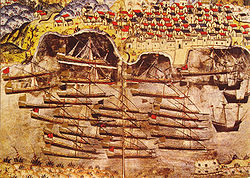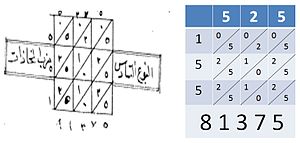- Matrakçı Nasuh
-
Nasuh bin Karagöz bin Abdullah el-Bosnavî (born in Visoko, Bosnia and Herzegovina), commonly known as Matrakçı Nasuh for his competence in the game called Matrak (also known as Nasuh el-Silâhî - Nasuh the Swordsman - because of his talent with weapons) was a 16th century Ottoman mathematician, teacher, historian, geographer, cartographer, swordmaster, and miniaturist of Bosniak origin. He was brought to Istanbul after being recruited by the Ottoman scouts in Rumalia, educated, served several Ottoman Sultans and became a teacher at Enderun School.[1]
Contents
Life
Matrakçı Nasuh, was a gifted Janissary of Bosnia who went through both the Infantry and devşirme system, a gifted swordsman and sharp shooter well known for his intellect; he spoke 5 languages and was recruited into the Ottoman Navy.
After a long period of studies on mathematics and geometry he wrote his works "Cemâlü'l-Küttâb" and "Kemalü'l- Hisâb" and submitted them to the Ottoman Sultan Selim I. He wrote also the two books named "Mecmaü't-Tevârih" and "Süleymannâme". They deal about the history of the period 1520 - 1543. He also wrote a historical piece on the Iran campaign of Suleiman I titled "Fetihname-i Karabuğdan".[2]
A recent study of his book, Umdet-ul Hisab revealed an unknown fact that Matraki had invented some genuine multiplication methods. One of the significant results displayed in this book was that the lattice method had been widely used in the Enderun nearly 50 years before John Napier introduced it to the Western world for the second time after al-Khwārizmī and Fibonacci[3]. Besides his works on mathematics and history he is very famous because of his miniatures. He created a naturalist style which focuses on panoramic views of landscapes and cities painted with the greatest detail (his most famous work, the Istanbul landscape picture, shows almost every street and building of the city). In Ottoman miniature art this was later known as "Matrakçı style". The most important of his four historic volumes of miniatures is that dealing with Suleiman I’s first Iran-Iraq campaign in 1534-35. Besides illustrating the march of the Ottoman army from Istanbul to Baghdad and then Tabriz and its return via Halab and Eskisehir, he also includes all the cities met by the army along the way. The Library of Istanbul University hosts the only copy of this unique work.
Nasuh was also a soldier and a master Bladesmith. He worked as a weapon teacher at Enderun School. He and his students demonstrated their skills in a show which was part of the circumcision celebrations of Suleiman I's sons. Because of his success in this demonstration Nasuh received the honorary title of Ustad (Master) and Reis (Chief) from the Sultan. He also wrote a book about usage of various weapons and techniques of cavalry and infantry fight, called "Tuhfet-ül Guzât".[4]
Works
Mathematics
- Cemâlü'l-Küttâb
- Kemalü'l- Hisâb
- Umdetü'l-Hisâb
History
- Mecmaü't-Tevârih (Sum of History)
- Süleymannâme (Book of Suleiman)
- Fetihname-i Karabuğdan (Book of Conquest of Black Bogdania)
- Beyan-ı Menazil-i Sefer-ul Irakeyn (Chronicle of Stages of Campaign of Iraq and Persia)
Martial Arts
- Tuhfet-ul Guzat (Gift of Warriors)
Gallery
References
- ^ http://www.muslimheritage.com/topics/default.cfm?articleID=853
- ^ http://www.muslimheritage.com/uploads/fortresses_of_Matrakci.jpg
- ^ http://tamu.academia.edu/SencerCorlu/Papers/471488/The_Ottoman_Palace_School_Enderun_and_the_Man_with_Multiple_Talents_Matrakci_Nasuh
- ^ http://www.muslimheritage.com/uploads/City_of_Diyarbakir_illumination.jpg
External links
Categories:- Ottoman mathematicians
- Ottoman historians
- Ottoman miniaturists
- Ottoman architects
- Ottoman people of Bosniak descent
- Bosniaks of Bosnia and Herzegovina
- Mathematicians
- Geographers
Wikimedia Foundation. 2010.






